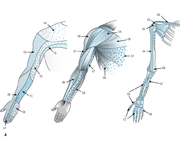Neuromechanics Weekly:
FEEL THE PAIN: PART 1
Pain Producing Tissues
What usually brings people in to see you or us? Sometimes, it is the desire for better performance, but most often it is pain. We see it daily in our offices. You see it daily in yours. In this installment of Neuromechanics, how about we characterize some of what we are seeing?
We like to think of pain as having one of four qualities: burning, aching/throbbing, sharp/stabbing, or electric/shooting. Each one tells us something about where it is coming from. Before we talk about that, we need to assess “What is the pain producing tissue?" To understand this further, we must delve deeper into tissue types.
We may remember from embryology, around the 3rd week of development, the embryo becomes trilaminar (three layers) forming, the endoderm, the mesoderm and the ectoderm. The endoderm becomes most of our organs (called the splanchnotome), the ectoderm becomes the nervous system, and the mesoderm becomes the muscles, ligaments and bones. The mesoderm coalesces and becomes blocks or segments of tissue called somites. These somites have 3 distinct parts: the dermatome, the myotome and the scerotome.
The dermatome becomes the skin, with it’s segmental innervation (the spinal cord level that supplies that area of skin). Think about when someone has an outbreak of shingles, which often follows a spinal nerve root distribution. We often test sensation along both dermatomal distributions (segmental) and peripheral nerve distributions (with contriobutions from many segmental nerves).
The myotome becomes the muscle and the segmental nerves which supply it. Each segmental level usually corresponds to a function (S1 does plantarflexion of the foot, L5 does dorsiflexion of the foot, etc). This is one of the reasons we muscle test, to tell us which segments may be involved in a problem.
The sclerotome becomes the bone, ligament and tendon supplied by one segmental level (ex. C5 does most of the upper humerus, lateral scapula and clavicle and shoulder capsule). It is what causes the pain associated with sprains or fractures. This is the pain of connective tissues (remember, connective tissues connect muscle to bone AND make up the ultrastructure of the muscle itself!) This is one of the most common pains we encounter in a clinical setting.
Knowing the tissue of origin often leads to a more specific diagnosis etiology of why your client/patient (or YOU) are having a problem.
Next time we delve deeper into pain. Until then, we remain, 2 good looking, aging, nerdy bald guys, Ivo and Shawn.


















